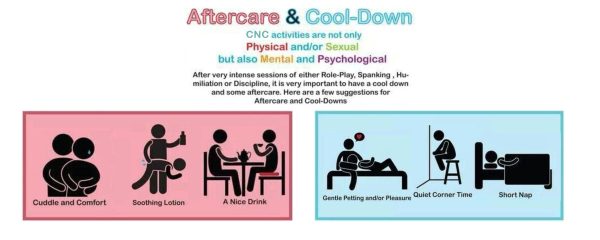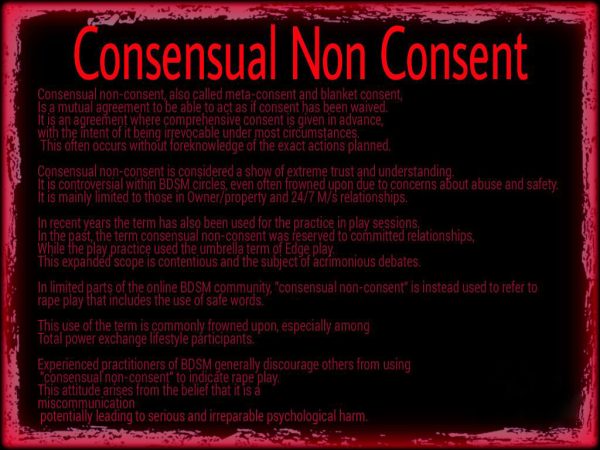Today, we'll delve into the captivating world of Consensual Non-Consent (CNC). It's a concept that may raise eyebrows but deserves our understanding nonetheless. Now, you might be wondering, "What the heck is Consensual Non-Consent?" Though CNC involves a heightened power dynamic, it's different from rape fantasy.
It also strictly adheres to rules, but it's more than the sexual aspect of a dom-sub relationship.
No matter what term you may use, CNC is all about respect, communication, and trust. It's an avenue to explore desires that lie beyond the realms of traditional consent. But why is it crucial to grasp the ins and outs of it? It's because understanding CNC enables safe navigation of the fantasy. Doing so also honors boundaries and fosters deeper connections between partners.
In this article, we'll delve into the intricacies and significance of CNC. By the end of it, you'll have insights into this consensual power dynamic and get the confidence you need. Are you ready to dive into the captivating world of Consensual Non-Consent? Let us empower you to embrace your desires and forge stronger connections. Let's get started!
Definition of Consensual Non-Consent
In a CNC dynamic, one person relinquishes control while the other dominates. The key here is consent. Both parties agree beforehand on the boundaries and limits.
CNC and Non-Consensual Acts
CNC differs from non-consensual acts in that CNC involves a consensual agreement. In CNC, individuals willingly engage in power dynamics and intimate play. Of course, within predefined rules and with clear communication.
Meanwhile, non-consensual acts lack consent. They are inherently abusive, violating personal boundaries and trust. CNC emphasizes trust, respect, and open communication. In contrast, non-consensual acts disregard consent and can cause harm.
The key distinction lies in CNC's consensual nature, which prioritizes all participants' well-being and desires.
CNC, Communication, and Boundaries
Communication is the bedrock of a healthy CNC relationship. It's crucial to discuss desires, fantasies, and limits in an open, honest manner. Clear and direct communication ensures that everyone involved is on the same page. This way, everyone involved can confidently explore their desires within a secure framework.
The Role of Consent in CNC Relationships
Let's dig deeper into the cornerstone of any CNC relationship: consent. In this topic, consent takes center stage, guiding every step within a CNC dynamic.
Consent and How It Works
Consent is an agreement between partners. It's not just a mere "yes" but a resounding "hell yes!" Consent means all participants understand the activities, risks, and boundaries involved. It's about being fully aware of what you're getting into and giving your explicit permission.
Informed Consent and Ongoing Communication
Consent is not a one-time deal. It's an ongoing process. You see, desires, limits, and boundaries can evolve. That's why continuous communication is vital. Regular check-ins and discussions allow everyone to adjust and grow. This also ensures that consent remains present and enthusiastic throughout the journey.
Remember, consent isn't something to be assumed or coerced. It should be freely given and respected without any pressure or manipulation.
Safety Considerations in CNC Relationships
When it comes to CNC, prioritizing safety is an absolute must. We want to explore desires and push boundaries, but we also want to do it responsibly.
Here are some tips for reducing risks during CNC play:
Always Communicate
Talk about limits, boundaries, and expectations with your partner. Make sure everyone involved understands and respects the agreed-upon rules. This creates a solid foundation where all parties feel safe and supported.
Be Prepared
Establish a safe word or signal that can halt any activity immediately. This signal communicates discomfort or the need for a break. Note that it's okay to hit the brakes and reassess if something doesn't feel right.
Take it Slow
Gradually exploring new territories is crucial. Rushing into intense scenes without proper preparation can lead to unexpected harm. Consider discussing and implementing aftercare strategies as well.
Educate Yourself
Learn about different BDSM practices, techniques, and safety measures. Attend workshops or seek advice from experienced individuals who can share valuable insights. The more knowledge you have, the better equipped you'll be.
Common Misconceptions About CNC
There's often a lot of misunderstanding and judgment regarding this subject. So, it's now time to set the record straight.
CNC is abusive
There's no place for abuse in a consensual CNC relationship. The keyword here is "consensual." All parties involved have voluntarily agreed to the activities they do.
Consent can't always be involved.
Consent knows no bounds, within reason, of course. While some acts may be intense, they can still be consensual as long as it's within the partners' agreement.
What does CNC encompass?
It involves power exchange, role play, and other fantasies partners want to explore. These desires usually lie beyond traditional consent. But it never oversteps what the partners agreed to.
CNC highlights safety and consensual surrender. It's the pushing of boundaries in a safe and trusting environment.
Aftercare in CNC Relationships
A crucial element often overlooked in CNC relationships is aftercare. This post-play phase is just as important as the intense scenes themselves. Aftercare is all about providing support and emotional support to a partner. It's a time to reconnect and address needs or problems that may have arisen during the scene.
Different Types of Aftercare
Aftercare can take various forms. It also depends on personal preferences and relationship dynamics.
Physical
Physical aftercare promotes intimacy, security, and relaxation. It establishes a nurturing bond and demonstrates the dom's care for the sub.
· Cuddling
· Massaging
· Hugging
· Applying lotion
· Cleaning sub-up
· Providing food or water
· Fetching blanket
Emotional
Emotional aftercare reinforces the emotional connection between partners. Showing a sub that they're valued also helps ease insecurities.
· Verbal affirmations ("You did amazing," "I'm here for you," or "You're safe with me")
· Active listening
· Offering reassurance
Debriefing and Reflection
Post-scene discussions deepen trust and strengthen the bond between partners. Debriefing allows for ongoing consent and communication. Ensuring that both partners' needs are acknowledged and met is vital.
Self-Care and Recovery
Giving each partner the freedom to have some alone time after a scene is crucial for decompressing and processing emotions. Respecting each other's need for solitude allows for individual healing and reflection.
Frequently Asked Questions (FAQs)
What is the difference between CNC and rape fantasies?
While CNC may involve elements of power exchange and simulated non-consensual acts, the key difference is consent. In CNC, all parties willingly agree to the dynamics and boundaries beforehand.
Versus rape fantasies, where a person fantasizes about non-consensual acts without consent. Consent is the crucial factor distinguishing CNC as a consensual and ethical exploration of desires.
How do I know if CNC is right for me?
Figuring out whether consensual non-consent suits you involves self-reflection and honest communication. Explore your desires, fantasies, and limits. Assess your comfort level with power dynamics and pushing boundaries.
Openly discuss these thoughts and feelings with a trusted partner. Take it slow, start with lighter forms of power play, and gradually explore if it aligns with your desires. Remember, consent, trust, and ongoing communication are essential in CNC.
Can CNC be abusive?
No. CNC, when practiced ethically, is built upon consent, trust, and respect. It's consensual and mutual. CNC also with predefined boundaries that focus on the partners' well-being. It's crucial to prioritize safety, emotional well-being, and mutual satisfaction in any CNC dynamic.
How do I bring up CNC with my partner?
Opening up a conversation about CNC requires clear communication and trust. Choose an appropriate time and place. It should be where both of you can have an open and non-judgmental discussion. Start by expressing your desires and curiosity about exploring power dynamics and boundaries.
Ask for your partner's thoughts, feelings, and comfort levels about it. Be prepared for a range of responses and respect their boundaries if they are uninterested.
Conclusion
In this article, we've embarked on an enlightening journey into CNC. Let's recap the key points we've covered:
· CNC is a consensual power dynamic where partners engage in intimate play with predefined boundaries and roles.
· Its values are clear communication, informed consent, and ongoing dialogue. It is important to establish and respect boundaries.
· Some common misconceptions about CNCare are that it can be abusive and that consent knows no bounds within reason.
· aftercare is critical in nurturing emotional well-being and maintaining trust.
CNC is a personal journey. Exploring it requires self-awareness, open communication, and mutual consent. Remember, everyone's desires and comfort levels may differ. It's crucial to respect and honor individual boundaries.
If you're considering delving into CNC, take your time, learn, and grow together with your partner. Prioritize safety, trust, and respect. Continuously check in with one another to ensure that everyone feels heard, supported, and fulfilled.































